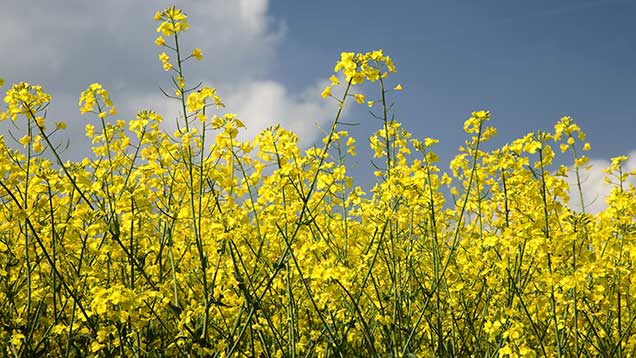Cereals 2015: Turnip yellows virus hotspots revealed in nationwide oilseed rape survey
 © Gisela Rentsch/imageBROKER/Rex Shutterstock
© Gisela Rentsch/imageBROKER/Rex Shutterstock Oilseed rape crops have been struck by up to 92% turnip yellows virus (TuYV) infection in parts of England this year, a new survey has confirmed.
The virus is spread by infected aphids and can cost growers up to 30% of their yield in bad cases.
The findings were described as “worrying” by John Walsh of Warwick University, who led the research on behalf of seed breader Limagrain.
He said: “Levels of infection are much higher than they have been for the past few seasons, with crops in parts of Yorkshire as much as 92% infected. Generally these hotspots are where you would expect them to be, due to the large areas of oilseed rape being grown locally.”
See also: Turnip yellows virus-resistant OSR may cut losses
He added that the survey showed some more surprising TuYV hotspots, such as a 74% infection in Somerset.
|
Survey area |
% of crop infected with TuYV |
|
Yorkshire |
72-92 |
|
Lincolnshire |
72-82 |
|
Somerset |
74 |
|
Wiltshire |
65 |
|
Wales |
46 |
|
Kent |
35 |
Presenting the results at Cereals 2015, Dr Walsh said the level of aphid activity in a season broadly correlates with the level of virus infection in oilseed rape crops.
“Last winter was mild and there were high levels of peach potato aphid, leading to very high levels of the virus,” he explained.
In years with high levels of infection, Dr Walsh found that even neonic-treated crops were infected.
This is because seed treatments only protect plants for up to 10 weeks after sowing and not against reinfection later in winter and in the following spring.
Chemistry
With neonic seed treatments unlikely to make a comeback soon, Limagrain’s senior oilseed rape breeder, Vasilis Gegas, said growers can no longer rely on pyrethroids to give effective control.
He said: “The chemistry isn’t working and as it becomes less effective, varietal resistance will become more important.”
Growers can use a pyrethroid spray to guard against aphid attack, but Dr Gegas explained that aphids are building a resistance to the current products available, adding that the spray can only be applied once and may not offer total protection for the duration of the aphid season.
Symptoms of an infected crop can easily be missed or confused with other nutritional deficiencies.
Early signs of TuYV are purpling of the leaves and later symptoms of interveinal yellowing and reddening of leaf margins are not usually shown before stem extension.
For more news, photos, video and information on the Cereals event see our Cereals 2015 page

